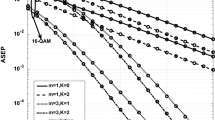Abstract
This paper presents an efficient and accurate performance evaluation technique for binary and quaternary direct-sequence spread-spectrum multiple-access (DS-SSMA) systems with deterministic signature sequences over Rician fading channels, without resorting to any (e.g. Gaussian) assumptions with respect to the distribution of the multiple-access interference (MAI). The method is based on a reduced-complexity formulation of the characteristic function method. In previous versions of this technique, the characteristic function of the MAI component of the decision statistic was expressed in terms of a double integral over the distributions of phase and delay. The new formulation, developed herein for both binary and quaternary modulation with a correlation receiver, generates a compact expression for the characteristic function of the MAI, eliminates the need for numerical integration over the phase distribution and yields a computational complexity reduction proportional to the spreading gain. This renders the characteristic function method more attractive for application to wideband CDMA systems and by extension, to more complex transceiver structures.
Similar content being viewed by others
References
K. Ben Letaief and M. Hamdi, “Efficient Simulation of CDMA Systems in Wireless Mobile Communications”, in Proc. of IEEE Globecom '95, Singapore, 1995, pp. 1799–1803.
R.K. Morrow and J.S. Lehnert, “Bit-to-bit Error Dependence in Slotted DS/SSMA Packet Systems with Random Signature Sequences”, IEEE Trans. Commun., Vol. 37, No.10, 1989, pp. 1052–1061.
J.M. Holtzman, “A Simple, Accurate Method to Calculate Spread-Spectrum Multiple-Access Error Probabilities”, IEEE Trans. Commun., Vol. 40, No.3, 1992, pp. 461–464.
J.S. Lehnert and M.B. Pursley, “Error Probabilities for Binary Direct-Sequence Spread-Spectrum Communications with Random Signature Sequences”, IEEE Trans. Commun., Vol. COM-35, No.1, 1987, pp. 87–98.
J.C. Liberti and T.S. Rappaport, “Accurate Techniques to Evaluate CDMA Bit Error Rates in Multipath Channels with Imperfect Power Control”, in Proc. of IEEE Globecom '95 (Comm. Theo. miniconf.), Singapore, 1995, pp. 33–37.
C.S. Gardner and J.A. Orr, “Fading Effects on the Performance of a Spread Spectrum Multiple Access Communication System”, IEEE Trans. Commun., Vol. 27, No.1, 1979, pp. 143–149.
Y.C. Yoon, R. Kohno and H. Imai, “A Spread Spectrum Multiaccess System with Cochannel Interference Cancellation for Multipath Fading Channels”, IEEE J. Sel. Areas Comm., Vol. 11, No.7, 1993, pp. 1067–1075.
M. Kavehrad, “Performance of Nondiversity Receivers for Spread Spectrum in Indoor Wireless Communication”, AT&T Tech. J., Vol. 64, No.6, 1985, pp. 1181–1210.
W.H. Lam and R. Steele, “Performance of Direct-Sequence Spread-Spectrum Multiple-Access Systems in Mobile Radio”, IEE Proc.-1, Vol. 138, No.1, 1991, pp. 1–14.
K.T. Wu and S.A. Tsaur, “Error Performance for Diversity DS-SSMA Communication in Fading Channels”, IEE Proc. Commun., Vol. 141, No.5, 1994, pp. 357–363.
E. Geraniotis, “Direct-Sequence Spread-Spectrum Multiple-Access Communications over Nonselective and Frequency-Selective Rician Fading Channels”, IEEE Trans. Commun., Vol. 34, No.8, 1986, pp. 756–764.
M.O. Sunay and P.J. McLane, “Performance of Selection Diversity for a DS CDMA System with Synchronization Errors”, in Proc. of IEEE ICUPC '95, Tokyo, Japan, 1995.
M.B. Pursley, “Spread-Spectrum Multiple-Access Communications”, in Multi-User Communication Systems. G. Longo (ed.), SpringerVerlag: Vienna and New York, 1981, pp. 139–199.
E.K. Hong, K.J. Kim and K.C. Whang, “Performance Evaluation of a DS-CDMA System with M-ary Orthogonal Signaling”, IEEE Trans. Veh. Tech., Vol. 45, 1996, pp. 57–62.
D. Liu and C.L. Despins, “A Reduced-Complexity Formulation for DS-SSMA Performance Evaluation via the Characteristic Function Method”, in Proc. of IEEE GLOBECOM '95 (Comm. Theo. miniconf.), Singapore, 1995, pp. 182–186.
D. Liu, “Efficient Evaluation of DS-CDMA Link Performance”, Ph.D. Dissertation, INRS-Télécommunications (Université du Québec), 1997.
C.W. Helstrom, “Calculating Error Probabilities for Intersymbol and Cochannel Interference”, IEEE Trans. Commun., Vol. COM-34, No.5, pp. 430–435, 1986.
M. Abramowitz and I.A. Stegun (eds.), Handbook of Mathematical Functions, National Bureau of Standards, Washington, 1964.
E.A. Geraniotis and M.B. Pursley, “Error Probability for Direct-Sequence Spread Spectrum Multiple-Access Communications-Part II: Approximations”, IEEE Trans. Commun., Vol. COM-30, No.5, pp. 985–995, 1982.
M.B. Pursley and H.F.A. Roefs, “Numerical Evaluation of Correlation Parameters for Optimal Phases of Binary Shift-Register Sequences”, IEEE Trans. Commun., vol. COM-27, pp. 1597–1604, 1979.
Author information
Authors and Affiliations
Rights and permissions
About this article
Cite this article
Liu, D., Despins, C.L. & Krzymien, W.A. Low-Complexity Performance Evaluation of Binary and Quaternary DS-SSMA over Rician Fading Channels via the Characteristic Function Method. Wireless Personal Communications 7, 257–273 (1998). https://doi.org/10.1023/A:1008866712744
Issue Date:
DOI: https://doi.org/10.1023/A:1008866712744




